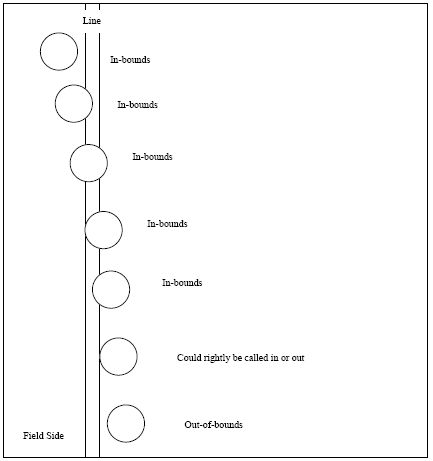BALL OUT OF PLAY: The ball is out of play when it has wholly crossed the goal line or touch line whether on the ground or in the air. It remains in play if any portion of the ball is above the goal line or touch line. Because of the way this rule is worded, spectators often think a goal has been scored, or the ball is out, when this is really not the case. It is also out of play when play has been stopped by the referee.

OFFSIDE POSITION: It is not an offense in itself to be in an offside
position.
A player is in an
offside position if:
* he is nearer to his opponents' goal line than both the ball and the
second last opponent
(this includes the keeper)
A player is not in an
offside position if:
* he is in his own half of the field of play
* he is even with the second last opponent
* he is even with the last two opponents
OFFSIDE PENALTY: A player in an offside position is only penalized if,
at the moment the ball touches or is played by one of his team, he is, in the opinion of
the referee, involved in active play by:
* interfering with play
* interfering with an opponent
* gaining an advantage by being in that position
There is no penalty if a player receives the ball directly from:
* a goal kick
* a throw-in
* a corner kick
For any offside offense, the referee awards an indirect free kick to the opposing team to
be taken from the place where the infringement occurred.
THE FIELD: The field of play must be rectangular. The length of the touch line (side line) must be greater than the length of the goal line (end line). Regulation fields are no shorter than 100 yds and no longer than 130 yds. Regulation fields are no narrower than 50 yds and no wider than 100 yds. "International Match" fields are held to tighter dimensions: Length = 110-120 yds, Width = 70 - 80 yds. For reference a high school football field is 120 yds long (including end zones) and 160 ft (53.33 yds) wide.
THE GOAL: The goal is 24 ft. wide by 8 ft. tall. The posts and crossbar must be white. Goals are located at the center of the goal line and the posts and cross bars are placed so their field-side edge is even with the field-side edge of the goal line. Ideally, the posts and cross bars are the same width as the goal line. The goal line (not the goal posts or cross bar) is used to determine if a score has occurred. Goals are scored when the ball passes totally past the goal line while remaining within the goal.
MARKINGS: Lines should be no wider than 5 inches. The field is divided into two halves by a halfway line. The center mark is indicated at the midpoint of the halfway line. A circle with a radius of 10 yds. is marked around the midpoint. The goal area is the 20 yd by 6 yd area immediately field side of and centered on the goal. The penalty area is the 44 yd by 18 yd area immediately field side of and centered on the goal. A penalty mark is made 12 yds from the midpoint between the goalposts and equidistant to them. An arc with a radius of 10 yds from the penalty mark is drawn outside the penalty area. A flagpost, not less than 5 ft high is placed at each corner. (Flagposts may also be placed at each end of the halfway line, not less than 1 yd outside the touch line). A corner arc with a radius of 1 yd is drawn from each corner post inside the field of play.